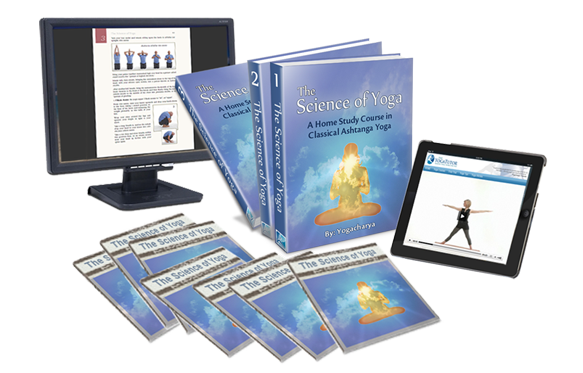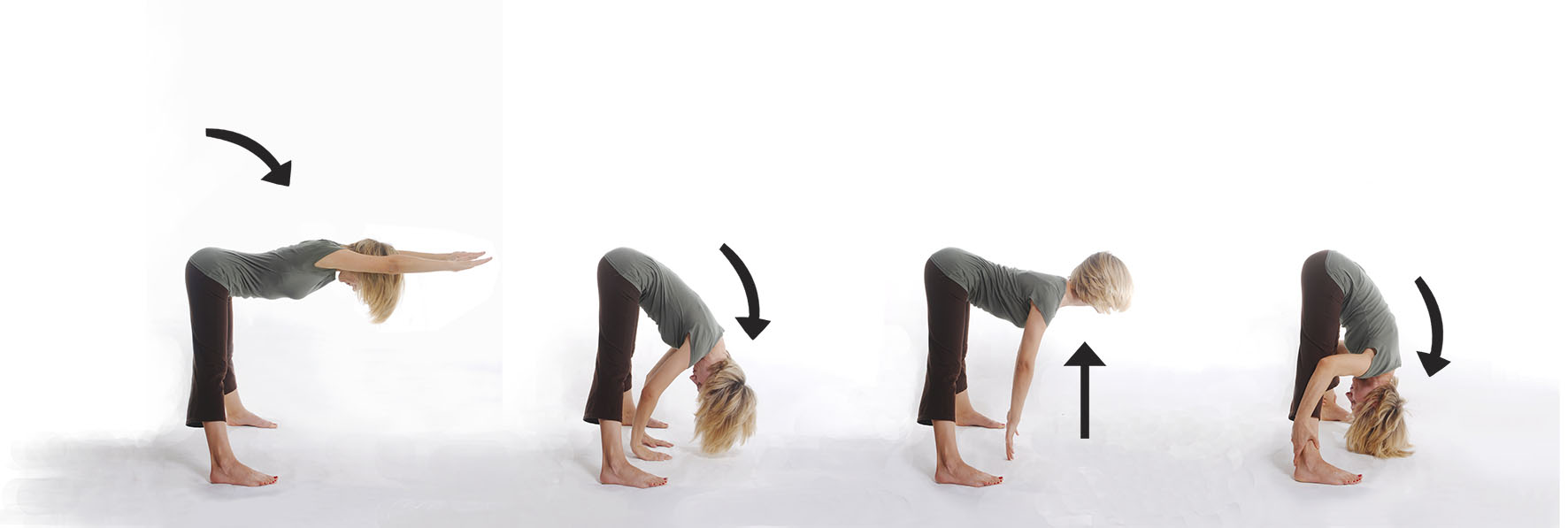[ Excerpt from The Science of Yoga, page 187 ]
Padottana asana is another excellent technique from our kona (angled) group of hatha yoga asanas. The name derives from the roots pada, which means foot, and utthana, which means "upright" or "to rise up." In this case, it follows the roots of ut (deliberate, intense) and tan (to stretch, extend, lengthen). Literally, padottana asana means "an intense stretch towards the foot."
Technique
- Begin from a relaxed sama sthiti asana.
- Jump or step your feet wide apart and extend your arms high overhead with the palms open and facing forward.
- On an exhale, slowly fold forward at the hips, at the same time keeping the spine straight, head up and arms extended.
- Allow your palms to come to rest about shoulder-width apart on the floor between your legs, and relax the spine, head and neck downward.
- Inhale and once again straighten your spine, raise your neck and head and lock your elbows straight, so that the weight of your body shifts upon your arms and hands.
- In this position, slide your feet a little wider apart. Your toes should be pointing straight forward and the soles flat on the ground.
- Again, exhale and allow your upper torso (head, neck and spine) to relax downward - ultimately trying to draw the top of your head down onto the floor directly between your feet.
- Hold this position for 20 to 30 seconds in the beginning.
NOTE: Several positions for the hands and arms are possible here, depending on your flexibility. You may maintain flat palms on the floor between your feet for added balance and support; you may grasp around to the sides of your feet and ankles, gently pulling yourself further into the stretch; or you may even interlock your fingers behind your back and extend the arms high overhead behind you (not shown).
- To come out of the pose, again place your palms flat on the floor about shoulder-width apart.
- Inhale and once again straighten your spine, raise your head and lock your elbows straight, so that the weight of your body shifts back onto your arms and hands.
- Gently walk/slide your feet a little closer together again.
- Inhale, extend your arms, and slowly lift back up, maintaining a straight spine throughout the movement.
- Hold this "upward stretch" for a couple full breaths.
- Step or jump back into sama sthiti asana.
Effects and Benefits
The hips are benefited greatly in this position, as the mechanical force serves to provide a stretch deep into the hip capsules where a great deal of tension results from chronic chair sitting. Its prolonged performance gives strength and stability to the ankles, knees and hips as well.
This pose provides a good stretch to the long muscles of the back and legs and washes the body free of a great deal of general stiffness. It is particularly good for opening up the sacral-iliac joints and relieving low-back tension.
As with pada hasta asana, this asana makes the spine resilient, straight and flexible, improving circulation of the blood throughout the body, making one feel invigorated afterwards. Also, as in the pada hasta asana, there is great emphasis on the flow of blood to the head in this posture, stimulating the senses and enlivening the mental function.
Similarly, padottana asana helps to free the passage of apana vayu, stimulating the excretory function and relieving constipation. In addition, it purifies and strengthens sushumna nadi and renders the body light by dispelling much tamas (dullness)...
[Continued...]
DISCLAIMER:
The contents of this web page are intended for informational purposes only. One should not engage in any yoga practices based solely upon the directions given on this web page or any other page of this web site. Anyone atempting to perform any of the yoga exercises introduced on this website assumes full responsibility and does so at their own risk.
---------------------
NOTE: This yoga article is an excerpt from The Science of Yoga, an online yoga training program with streaming yoga videos and 600 pages of step-by-step yoga instruction.

"The Science of Yoga is a course worthy of
leather binding and an honored place in the
finest libraries in the world
... It is indeed a masterful work."
Dr. John Michael Christian
AwakeningWithYoga.com
Learn More About
The Science of Yoga Course
|







